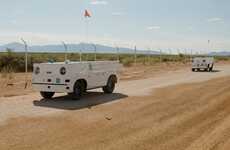
This Robotic Vehicle Has 360-Degree Vision and AI Navigation
Rahul Kalvapalle — January 15, 2021 — Autos
References: milremrobotics & newatlas
Estonian robotic vehicle manufacturer Milirem Robotics has unveiled a high-tech combat vehicle that uses autonomous technology to provide highly reliable reconnaissance and tactical support to military units from a modular package.
The Type-X Robotic Combat Vehicle's modular design is built around an autonomous structure that can be used with a variety of payloads, offering a range of tactical possibilities from a robotic package that reduces the risks faced by human soldiers.
This combat vehicle is only 68 cm tall and can attain a top speed of 80 km/h, with its 360-degree vision and array of thermal cameras working in conjunction with an artificial intelligence system to allow the vehicle to navigate safely and stealthily and in accordance with mission objectives.
With its suite of high-tech autonomous features and flexible utility, the Type-X Robotic Combat Vehicle represents a step into the next generation of military operations.
The Type-X Robotic Combat Vehicle's modular design is built around an autonomous structure that can be used with a variety of payloads, offering a range of tactical possibilities from a robotic package that reduces the risks faced by human soldiers.
This combat vehicle is only 68 cm tall and can attain a top speed of 80 km/h, with its 360-degree vision and array of thermal cameras working in conjunction with an artificial intelligence system to allow the vehicle to navigate safely and stealthily and in accordance with mission objectives.
With its suite of high-tech autonomous features and flexible utility, the Type-X Robotic Combat Vehicle represents a step into the next generation of military operations.
Trend Themes
1. Autonomous Combat Vehicles - The development of autonomous combat vehicles will create opportunities for robotic weaponry and military vehicles.
2. Modular Design - Modular design will disrupt traditional military vehicle construction and create opportunities for innovation in lightweight materials and interchangeable payloads.
3. AI Navigation - The use of AI navigation technology in military vehicles will have disrupt industry and have implications for civilian autonomous vehicles.
Industry Implications
1. Defense Industry - The defense industry must adapt to the rise of autonomous combat vehicles to remain competitive.
2. Engineering Industry - The engineering industry must innovate to meet the demands of modular design in military vehicles.
3. Autonomous Vehicle Industry - The autonomous vehicle industry can learn from the development of AI navigation technology in military vehicles to improve civilian applications.
2.2
Score
Popularity
Activity
Freshness























